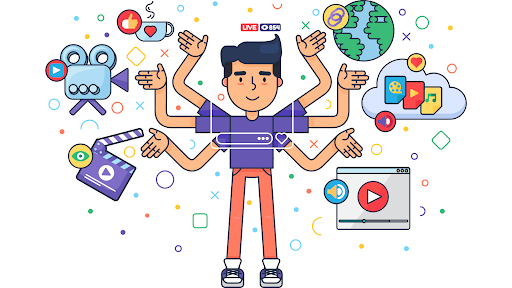The most difficult obstacle to overcome when it comes to engaging an online audience is convincing individuals to take part.
However, when it comes to strategic, technological, and sociological challenges, virtual presentations create additional challenges. The business has additional challenges when it integrates virtual events into employer branding campaigns. In order for digital experiences to have the desired effect on how the employer brand is perceived, these issues must be resolved. This section looks into common issues and makes recommendations for workable solutions.
Common Challenges in Integrating Virtual Events and Employer Branding:
Technical Issues:
In the event that technical difficulties or network glitches cause virtual events to malfunction, attendees may become frustrated and their whole experience may suffer. To mitigate the effects of these problems, a strong technical basis is needed.
Audience Engagement:
Keeping the audience engaged and interested at any event can be tricky as it is, and this is even more pronounced in a virtual event. The lack of in-person meetings could be a rather huge challenge for companies looking to find top talent via employer branding campaigns.

Brand Consistency:
Delivering a consistent brand narrative across all touchpoints of a virtual event is crucial, including speeches, virtual booths, and marketing materials. An inconsistent message, appearance, or tone could cause misinterpretations, and could dampen the employer branding efforts.
Measurement and ROI:
Determining performance metrics and return on investment (ROI) for virtual events can be challenging. The absence of clear guidelines makes it challenging to develop relevant parameters to assess the impact of the employer branding initiatives. This entails assessing how the brand is seen, how talent is acquired, and how engaged people are.
Here Are Some Effective Solutions To Host World-Class Virtual Events For Employer Branding
Challenges | Possible Solutions |
Insufficient Engagement | – Interactive components: Use gamification, surveys, Q&A sessions, live chats, and breakout spaces. – Diverse content format: a combination of social media integration, demos, panel discussions, interviews, and presentations. – Pre-event interaction: Send out teasers, organize challenges ahead of time, provide early access to content. – Post-event: Disseminate recordings, highlights, and provide chances for networking. |
Insufficient Possibilities for Networking | – Tools for virtual networking: gamified challenges that promote interaction, virtual booths, speed networking rounds, and dedicated platforms for one-on-one encounters. – Social activities and icebreakers: interactive Q&A sessions, surveys, games, and discussion starters in separate rooms. – Pre-event blind networking: Prior to the event, match people with shared interests using questionnaires or algorithms. – Post-event: Host online communities or groups, distribute the contact details of pertinent attendees. |
Challenges Communicating Corporate Culture | – Genuine storytelling: Involve team members in informal Q&A sessions, behind-the-scenes tours, and employee testimonials. – Interactive exercises: live demonstrations of the company’s product or services, virtual workplace visits, and gamified tasks that represent company values. – Visual branding: All event materials should consistently use the company’s colors, logos, typefaces, and photography. – Social media integration: Invite guests to use branded filters and/or hashtags while sharing their experiences on social media. |
Technical Problems | – Select a trustworthy platform: Conduct in-depth study, comprehend the capabilities and constraints of the platform, and test everything beforehand. – Get ready for emergencies: Make backup plans in case of unforeseen glitches, internet outages, or other tech issues. – Give precise directions: Provide participants with thorough instructions, an FAQ section, and troubleshooting advice. – Provide technical assistance: Throughout the event, have a dedicated member of tech support team on hand to help participants with any technical difficulties. |
Solutions and Best Practices:

Now let’s dive into the best practices of the Employer Branding:
Technological Infrastructure:
- Investing in reputable virtual event platforms that have a track record of offering reliable service and technical support is crucial to lowering the chance of running into technical issues.
- To ensure that everything runs as well as possible for all parties involved, it is imperative that multiple rounds of rehearsals and tests be conducted in the days preceding the event.
Planning and Delivering Content:
- Design sessions and activities that promote participation if you want your audience to be actively involved with your content. Question-and-answer sessions, breakout groups, and surveys are excellent means of stimulating discussions among participants.
- Make sure that your presentations are engaging and visually appealing in order to hold the listeners’ attention. Employer branding messages can be conveyed successfully by using multimedia elements and narrative techniques.
Branding Requirements for Online Platforms:
- We must be aware of all the regulations governing virtual events before we can establish brand standards for the appearance and behavior. Using colors, logos, and messaging consistently should be part of these guidelines. Please make sure that everyone who contributes is aware of these rules so that the integrity and consistency of the brand are preserved.

- Presenters and contributors will have the chance to learn about the employer brand guidelines by taking part in training sessions. This will help to maintain the employer brands’ consistent image.
Success Metrics:
- Specify the key performance indicators (KPIs) as well as the employer branding objectives. Metrics should be set up to track post-event opinions about the brand as well as participant involvement and satisfaction.
- Post event, it’s critical to get input through surveys regarding the event’s influence on the company’s branding. Close the loop on audience feedback and make adjustments in your upcoming events to deliver consistently high-quality events.
Conclusion
There are a number of moving parts involved in employer branding and virtual events. Some of these moving parts include the requirement for consistent messaging, the challenges of communicating with the audience, and the challenges posed by technology.

The incorporation of interactive components, investing in robust and reliable technology, and the adherence to branding requirements are all ways in which these problems can be resolved. Businesses have the potential to improve their employer brand and provide their employees with a more positive virtual experience if they take the initiative.
Frequently asked questions
Enhancing your employer brand through virtual events involves showcasing your company’s culture and values. Utilize interactive and engaging content on virtual platforms to highlight what makes your company a great place to work.
To ensure attendees are engaged and have a positive experience, incorporate interactive features such as live Q&A, polls, and virtual team building exercises. Keep content dynamic and tailored to your audience’s interests. Promote your event through social media and a well-designed event registration page to build anticipation.
Use virtual event platforms with networking features like breakout rooms and one-on-one chats to mimic in-person interactions. Facilitate active participation and direct introductions among attendees to foster genuine connections, enhancing the networking value of virtual events.
Market your virtual career fair through social media, professional networks, and email campaigns targeted at your desired audience. Highlight the benefits of attending, such as networking opportunities and insights into your company culture. A user-friendly and engaging virtual environment is key to attracting top talent.
Create a comprehensive virtual onboarding program featuring team introductions, culture workshops, and training sessions. Use virtual tours to give a sense of the office space and ensure new hires have ample opportunities to interact with their colleagues and ask questions, making the virtual onboarding experience effective and welcoming.
Toggle Content
Successful virtual team building involves activities that promote teamwork, communication, and fun. Choose inclusive activities that cater to the diverse interests of your team. Utilize interactive virtual event platforms to encourage full participation and enhance team cohesion.
Toggle Content
To achieve high registration and attendance, market your event through diverse channels and offer early registration incentives. Simplify the registration process and ensure your event content is compelling. Engaging marketing strategies and user-friendly registration experiences are essential for high attendee numbers.
Hybrid events can strengthen your employer brand by combining the reach of virtual events with the impact of in-person experiences. Ensure both virtual and live attendees receive engaging and consistent brand messaging. This approach allows for a broader audience while creating immersive brand experiences.
Set clear goals for your event and branding efforts, such as brand awareness or employee engagement improvements. Use engagement metrics, social media activity, attendee feedback, and follow-up inquiries as indicators of success. Clear objectives and measurable outcomes are crucial for assessing the impact of your virtual events on employer branding.
Send personalized thank you messages and share event highlights to keep the conversation going. Invite feedback to show you value their input and keep them informed about future opportunities. Effective follow-up strengthens relationships and reinforces your employer brand.




























